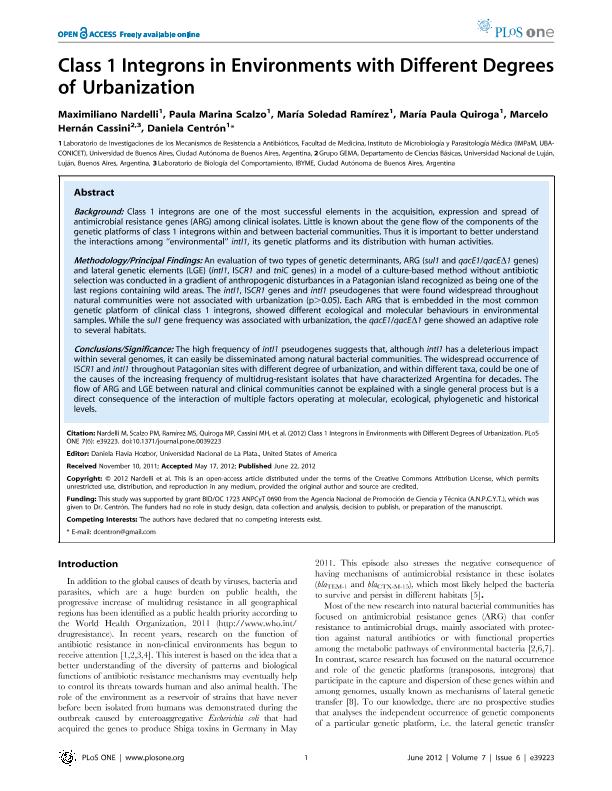Artículo
Class 1 Integrons in Environments with Different Degrees of Urbanization
Nardelli, Maximiliano ; Scalzo, Paula Marina
; Scalzo, Paula Marina ; Ramirez, Maria Soledad
; Ramirez, Maria Soledad ; Quiroga, Maria Paula
; Quiroga, Maria Paula ; Cassini, Marcelo Hernan
; Cassini, Marcelo Hernan ; Centron, Daniela
; Centron, Daniela
 ; Scalzo, Paula Marina
; Scalzo, Paula Marina ; Ramirez, Maria Soledad
; Ramirez, Maria Soledad ; Quiroga, Maria Paula
; Quiroga, Maria Paula ; Cassini, Marcelo Hernan
; Cassini, Marcelo Hernan ; Centron, Daniela
; Centron, Daniela
Fecha de publicación:
22/06/2012
Editorial:
Public Library of Science
Revista:
Plos One
ISSN:
1932-6203
Idioma:
Inglés
Tipo de recurso:
Artículo publicado
Clasificación temática:
Resumen
Background: Class 1 integrons are one of the most successful elements in the acquisition, expression and spread of antimicrobial resistance genes (ARG) among clinical isolates. Little is known about the gene flow of the components of the genetic platforms of class 1 integrons within and between bacterial communities. Thus it is important to better understand the interactions among ‘‘environmental’’ intI1, its genetic platforms and its distribution with human activities. Methodology/Principal Findings: An evaluation of two types of genetic determinants, ARG (sul1 and qacE1/qacED1 genes) and lateral genetic elements (LGE) (intI1, ISCR1 and tniC genes) in a model of a culture-based method without antibiotic selection was conducted in a gradient of anthropogenic disturbances in a Patagonian island recognized as being one of the last regions containing wild areas. The intI1, ISCR1 genes and intI1 pseudogenes that were found widespread throughout natural communities were not associated with urbanization (p.0.05). Each ARG that is embedded in the most common genetic platform of clinical class 1 integrons, showed different ecological and molecular behaviours in environmental samples. While the sul1 gene frequency was associated with urbanization, the qacE1/qacED1 gene showed an adaptive role to several habitats. Conclusions/Significance: The high frequency of intI1 pseudogenes suggests that, although intI1 has a deleterious impact within several genomes, it can easily be disseminated among natural bacterial communities. The widespread occurrence of ISCR1 and intI1 throughout Patagonian sites with different degree of urbanization, and within different taxa, could be one of the causes of the increasing frequency of multidrug-resistant isolates that have characterized Argentina for decades. The flow of ARG and LGE between natural and clinical communities cannot be explained with a single general process but is a direct consequence of the interaction of multiple factors operating at molecular, ecological, phylogenetic and historical levels.
Archivos asociados
Licencia
Identificadores
Colecciones
Articulos(IBYME)
Articulos de INST.DE BIOLOGIA Y MEDICINA EXPERIMENTAL (I)
Articulos de INST.DE BIOLOGIA Y MEDICINA EXPERIMENTAL (I)
Citación
Nardelli, Maximiliano; Scalzo, Paula Marina; Ramirez, Maria Soledad; Quiroga, Maria Paula; Cassini, Marcelo Hernan; et al.; Class 1 Integrons in Environments with Different Degrees of Urbanization; Public Library of Science; Plos One; 7; 6; 22-6-2012; 1-13; e39223
Compartir
Altmétricas



